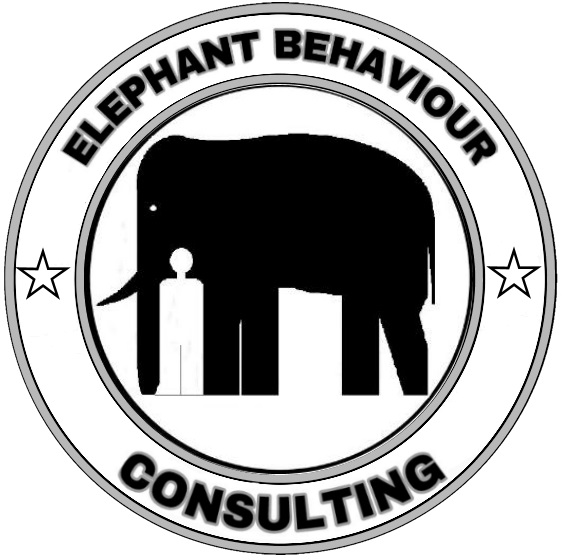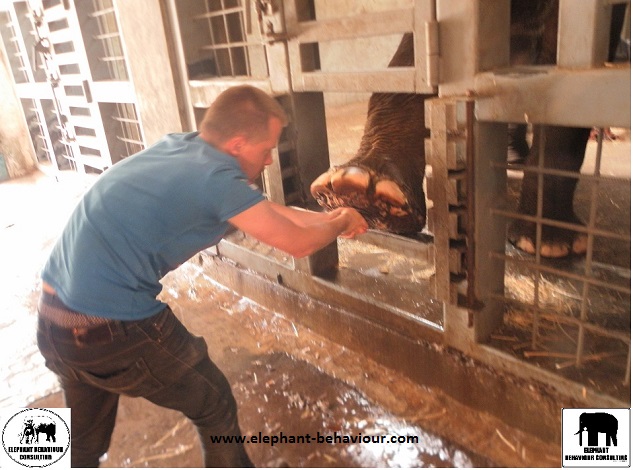Behavioural Enrichment & Protected Contact
1. Different kinds of behavioural enrichment for elephants in zoos.
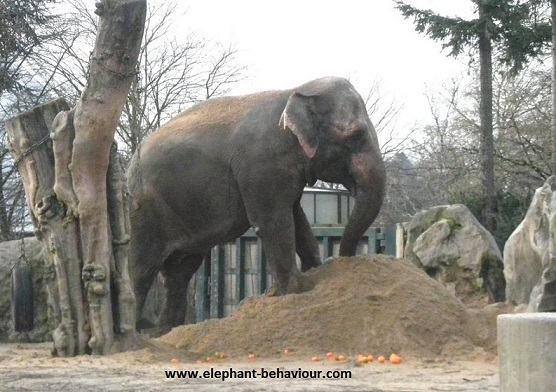
A Behavioural-Enrichment Study about Asian Elephants in Zoos.
Abstract:
The question of this study was: Have Enrichment programs a measurable, positive Effect on the behavior of elephants?
In order to identify the potential success of enrichment programs, I observated the elephant-bull called "Bunka" on different days with scientific methods and meticulous accuracy.
The first experiment was to feed the elephant-bull "Bunka" with fifty apples. On the first pass, the apples were fed on a pile (“old school”).
On the second pass, the apples were hidden everywhere in the enclosure.
The result: "Bunka" took three minutes to devour the fifty apples that were presented to him in a heap/pile. To search the apples in the enclosure and eat it took seven minutes and showed, in addition to the feed intake also search-behavior and locomotion.
The duration of feed intake was increased by more than 130%.
In another experiment, I have observed again the duration of feed intake (incl. seeking behavior). This time the elephant-bull called "Bunka" get about 10 kg of fruit and vegetables and some hay: Ten times with the conventional feeding method, where everything is available on a big pile on the floor. And ten times with the Enrichment Programm, that means hidden everywhere in the enclosure and hung in the hay net.
In feedings without enrichment programs "Bunka" needed about 17 min (minimal even only 12 mins) time for feed intake.
In feedings with Enichment programs "Bunka" needed about 51 minutes (maximum 71 minutes even) time for feed intake.
This results means that with the Enichment programs “Bunka” needed to increase the duration of feed intake by an average of 200%.
Conclusion:
Enrichment programs for elephants, especially by foraging, have an enormous importance for the behaviour of elephant (as close to nature as possible) and the welfare of elephants in zoos.
Orginal source:
DORNBUSCH, T. 2016. Enrichment-Programm im Zoo Yerevan. Elefanten in Zoo und Circus. Das Elefanten-Magazin 28: 63 – 65.
http://elephant-behaviour.com/data/documents/28_EnrichmentZooYerevan_2016.pdf
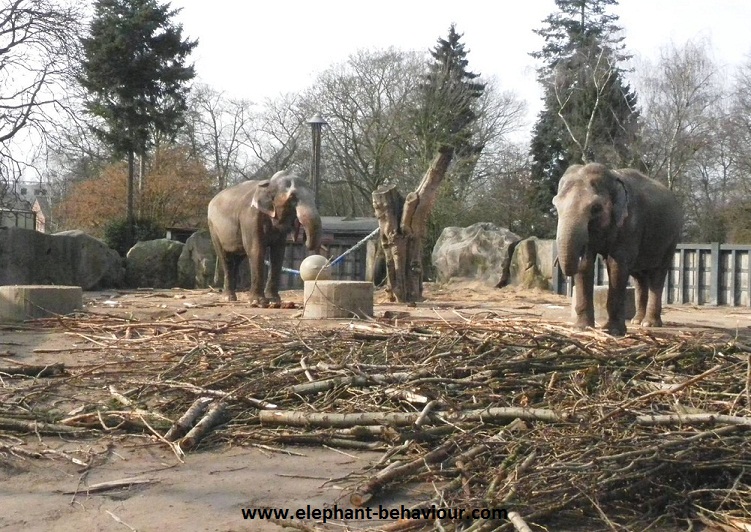
Much branches are one of the best and most natural Enrichment for Elephants. Photo: T. Dornbusch.
Here is an Video-Link, about "How to built an Hayfeeder for Elephants":
https://www.youtube.com/watch?v=l_1n3nFf1Y4
2. Protected Contact
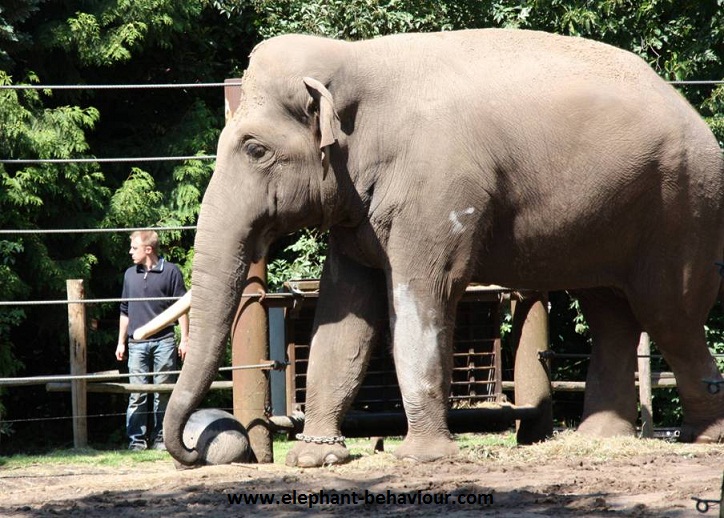
At first Protected Contact was successfully used to take care for elephant-bulls in Zoos.
Translation into English follows...
Um Elefanten in Zoos zu halten gibt es verschiedene Haltungssysteme. Zu einen den so genannten "Free Contact", bei dem die Elefantenpfleger direkten Kontakt mit den Elefanten haben. Dieses Haltungssystem hat jedoch mehrere Nachteile: Es setzt die Lebenslange Unterwerfung des Elefanten an den Menschen vorraus und es birgt eine große Unfallgefahr für die Tierpfleger. Aus diesen Gründen wird dieses Haltungssystem heute als unmodern und tierschutzrelevant eingestuft.
Protected Contact is succssfull to avoiding accidents and to give good care for the elephants, without the threar of an elephant-hook.
Im Gegensatz dazu ist das andere Haltungssystem, der so genannte "Protected Contact", bei dem die Elefantenpfleger stets durch ein Schutzgitter von den Elefanten getrennt sind. Dieses Hatungssystem basiert auf einer freiwilligen Kooperation zwischen den Elefanten und den Tierpflegern. Es ist daher tiergerechter und es bietet deutlich mehr Arbeitssicherheit für das Personal.
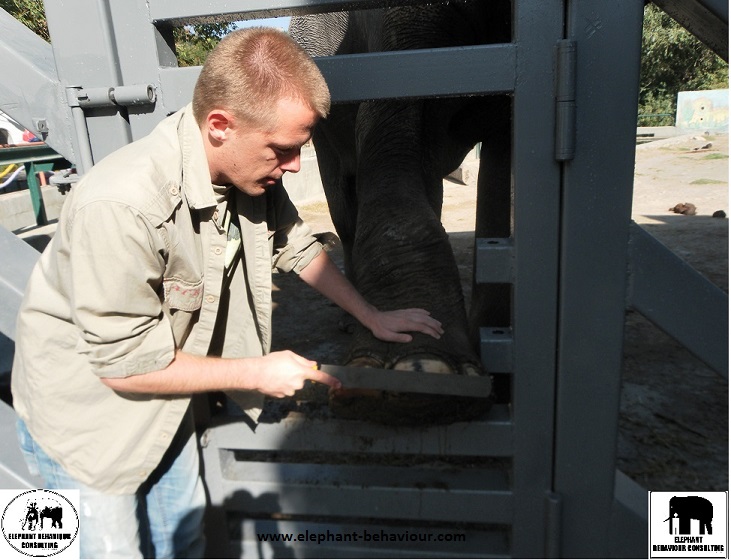
Today the most Zoos in the westhern world use Protected Contact for the care of male and female elephants.
Der "Protected Contact" wurde zuerst zur Haltung von Elefantenbullen entwickelt, da diese sich deutlich schlechter vom Menschen dominieren lassen und eine Haltung im "Free Contact" daher praktisch nicht möglih ist. Inzwischen wird der "Protected Contact" jedoch auch erfolgreich bei der Haltung von Elefantenkühen eingesetzt.
Target-Training

A typical Protected Contact-Wall for Target-Trainig in an Zoo in the Netherlands.
Um im "Protected Contact" Elefanten medizinisch besser behandeln zu können, wurde ein so genanntes Target-Training entwickelt, dass auf der freiweilligen Bereitschaft der Elefanten auf Belohnungsbasis basiert. Den Elefanten wird dabei mittels einer Zeigestange beigebracht, ihre Füße, Ohren usw. durch Fenster in einer Schutzwand zu strecken. So können die jeweiligen Körperteile vom Personal untersucht bzw. behandelt werden, ohne dass eine Gefahr für das Personal entsteht.
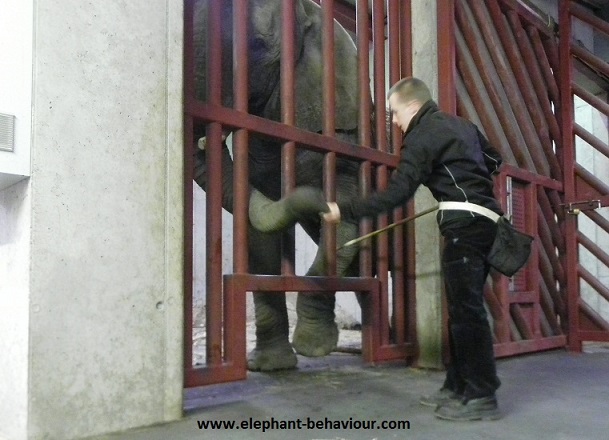
Target-Training with an female African elephant.
Das Haltungssystem "Protected Contact" mit seinem Stresslosen Target-Training orientiert sich am natürlichen Verhalten der Elefanten und ist daher ein weit aus besseres und moderneres Haltungssystem, als die Tiere im "Free Contact" (unter der Dominanz des Menschen) zu halten.
Text: Tobias Dornbusch
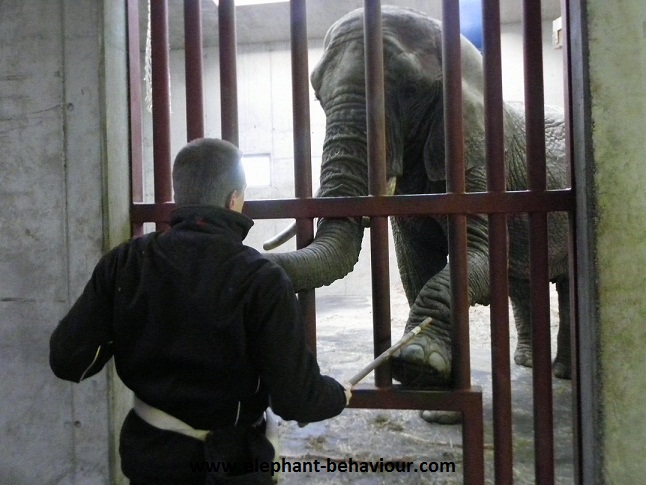
Training with "Mirry", an female African elephant.
For more information, please read the following reports:
Original source: DORNBUSCH T. 2012. Die Elefanten-Savanne im Olmense Zoo. Elefanten in Zoo und Circus. Das Elefanten-Magazin 22: 31 - 33.
http://elephant-behaviour.com/data/documents/22_olmensezoo_2012.pdf
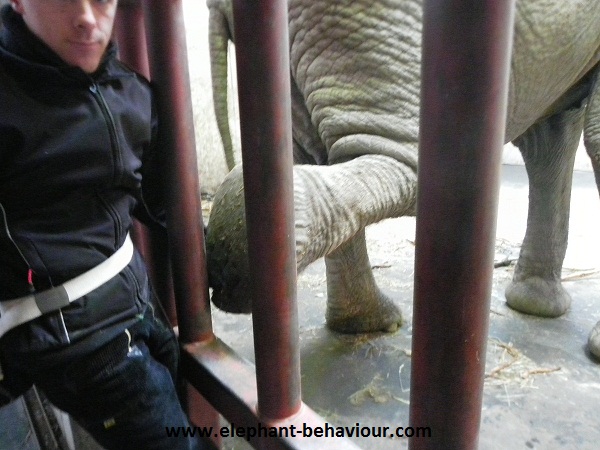
A back-feet of African elephant-cow "Betty".
Foot Care
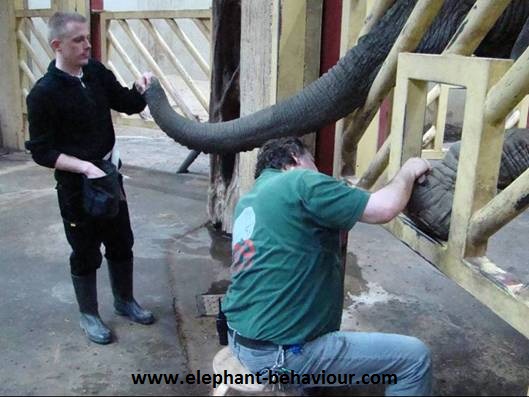
Foot care by an female African elephant.
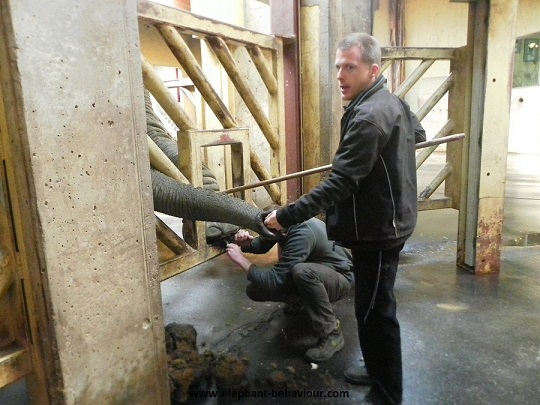
Foot-care with the African elephant-cow "Mirry" at Zoo Osnabrück. Foto: J. J. Long.
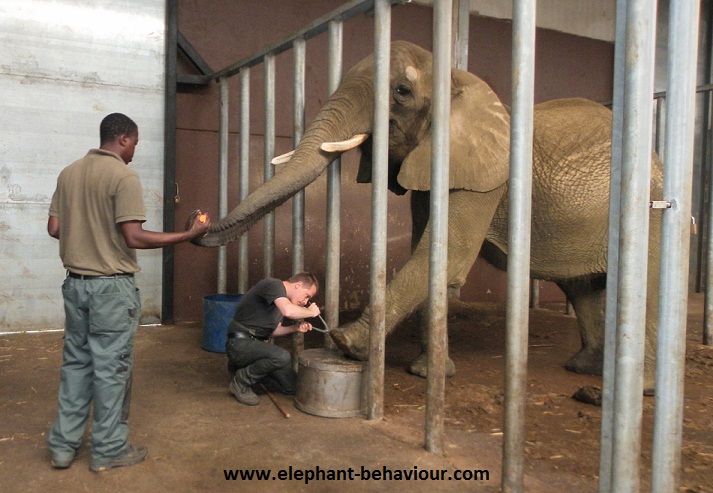
Foot-care by the African elephant-cow "Kariba" in Olmense Zoo, B. Left: James Kgwedi;
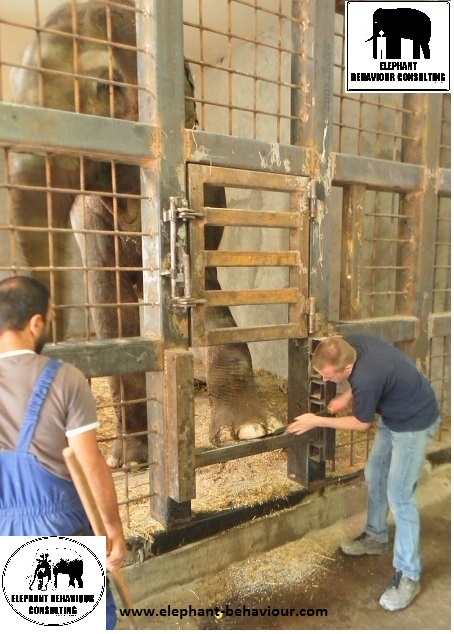
Elephant Foot-care with Elephantbull "Grand".
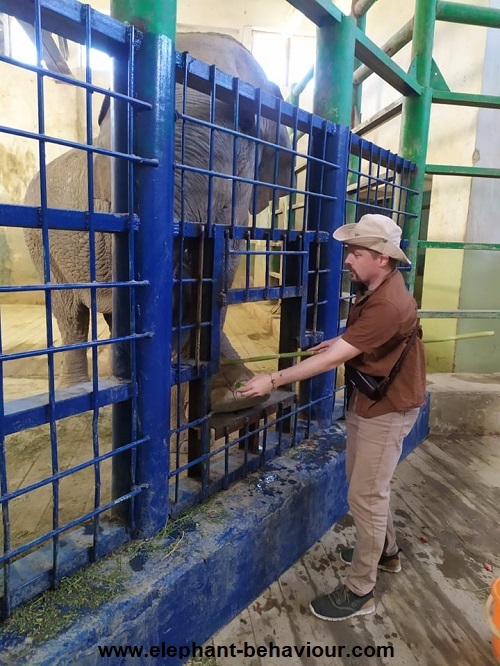
Tobias Dornbusch training the Asian elepehant female "Putri" at Tashkent Zoo, UZB.
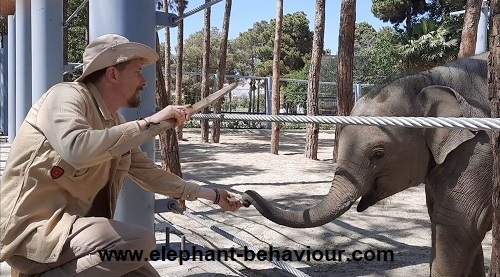
Training the one year old elephant-calf "Maysa" at Tehran Zoo. Foto: T. Dornbusch-Archiv.
For more informations about elephant behavioural enrichment write me an e-mail, please.
(c) All pictures by Tobias Dornbusch.

